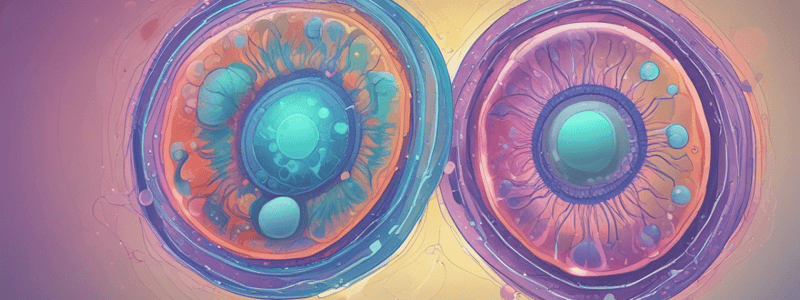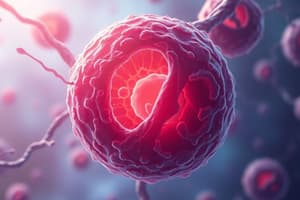Podcast
Questions and Answers
What is the common origin of all cells in the human body?
What is the common origin of all cells in the human body?
- Muscle cells
- Gene cells
- Somatic cells
- Stem cells (correct)
What is the purpose of genes in our DNA?
What is the purpose of genes in our DNA?
- To provide structure to the nucleus
- To give specific instructions for making different proteins (correct)
- To regulate cell growth and death
- To give instructions for cellular division
What is unique about red blood cells?
What is unique about red blood cells?
- They are the only type of stem cell
- They have a nucleus like all other cells
- They have a unique function in the body
- They lack a nucleus (correct)
What is the role of DNA in the development of cells?
What is the role of DNA in the development of cells?
What is the analogy used to describe the relationship between genes and DNA?
What is the analogy used to describe the relationship between genes and DNA?
Why do different cells in the body have different functions?
Why do different cells in the body have different functions?
What is the term used to describe cells that are completely unspecialized?
What is the term used to describe cells that are completely unspecialized?
What determines the characteristics of a cell?
What determines the characteristics of a cell?
What is inductive signaling or induction similar to?
What is inductive signaling or induction similar to?
How can signals be passed during induction?
How can signals be passed during induction?
What is the ultimate goal of cell specialization?
What is the ultimate goal of cell specialization?
What is the name of the proteins that make up part of a gap junction?
What is the name of the proteins that make up part of a gap junction?
What body parts are formed partially through induction?
What body parts are formed partially through induction?
What is another way to specialize cells, apart from induction?
What is another way to specialize cells, apart from induction?
What is the term used to describe the direct binding of surface proteins on cells?
What is the term used to describe the direct binding of surface proteins on cells?
What is the result of cell specialization?
What is the result of cell specialization?
What does a cell do when it's said to be expressing a certain gene?
What does a cell do when it's said to be expressing a certain gene?
What happens when a stem cell differentiates into a muscle cell?
What happens when a stem cell differentiates into a muscle cell?
What is true about mature cells that have already differentiated?
What is true about mature cells that have already differentiated?
What determines what a cell will specialize into?
What determines what a cell will specialize into?
What is the role of transcription factors in cell differentiation?
What is the role of transcription factors in cell differentiation?
What is asymmetric segregation of cellular determinants?
What is asymmetric segregation of cellular determinants?
What happens to the transcription factors during cell division?
What happens to the transcription factors during cell division?
What is the term for the precursors of transcription factors?
What is the term for the precursors of transcription factors?
What is true about pluripotent stem cells?
What is true about pluripotent stem cells?
What determines the fate of a cell during development?
What determines the fate of a cell during development?
Flashcards are hidden until you start studying
Study Notes
Stem Cells and Differentiation
- Stem cells are unspecialized cells that can develop into different cell types during development.
- All cells in the human body come from a common group of stem cells.
- Stem cells differentiate into specialized cells through gene expression.
Analogy: Library and Genes
- Genes are like books in a library, containing instructions for making proteins.
- Each cell has the same DNA library, but uses different genes (books) to make proteins.
- Cells are like readers, using different books to gain different abilities.
Gene Expression
- Gene expression: when a cell uses certain genes to make proteins.
- Genes being expressed are "turned on", while others are "turned off".
- Stem cells differentiate by turning on specific genes and turning off others.
Muscle Cell and Neuron Differentiation
- Stem cells turn on muscle cell genes to produce proteins, changing cell shape and function.
- Stem cells turn on neuron genes to produce proteins, changing cell shape and function.
- Specialized cells can't de-differentiate back into stem cells.
Cell Specialization Cues
- Cells receive internal and external cues to specialize into different cell types.
- Cues can come from transcription factors, asymmetric segregation, or inductive signaling.
Asymmetric Segregation of Cellular Determinants
- Transcription factors are clustered in specific areas of the zygote.
- When the zygote divides, transcription factors are asymmetrically distributed among daughter cells.
- Different genes are activated in each cell, determining cell specialization.
Inductive Signaling (Induction)
- Induction is a process where cells or groups of cells induce other cells to differentiate.
- Induction can occur through diffusion, direct contact, or gap junctions.
- Induction is crucial for forming body parts, like limbs, ears, and eyes.
Goal of Cell Specialization
- The goal of cell specialization is to change gene expression, turning on or off specific genes.
- This ultimately leads to cells differentiating into more specialized cell types.
Studying That Suits You
Use AI to generate personalized quizzes and flashcards to suit your learning preferences.



